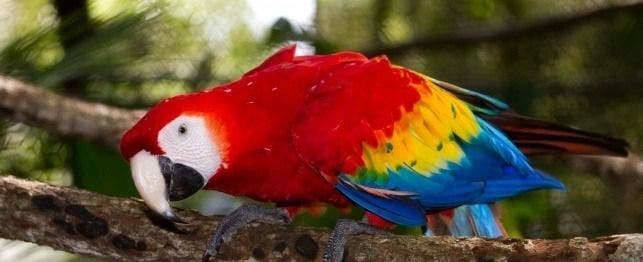
Choosing a Scarlet Macaw
Scarlet macaws are prized for their beauty and personality. Lively and intelligent, they are easy to train, which makes them a favorite choice for people who want a bird that will readily pick up on games and tricks.
Like most great show-offs, though, they can be a little overbearing: Boisterous to a fault, they can be downright loud. They can also be destructive, and, when provoked, can be nippy. While some do learn to speak, most macaws have limited ability to mimic.
Since they are playful and love to chew, they need toys – especially wooden blocks and branches from non-toxic trees. Young macaws should be socialized to many people and exposed to a variety of situations such as new cages, toys, visits to the veterinarian, wing and nail clips, to avoid fear of new people and places. While macaws are not as long-lived as cockatoos, some scarlets live to be 50.
Also known as red and yellow macaws or Ara macao, the birds have an extensive range throughout most of the Amazon basin of tropical South America. South American scarlets have green tips on yellow wing coverts. The largest and most striking scarlets are found in Nicaragua – a population, which was recently described as a subspecies – and have little or no green on the wing.
In the wild, the birds inhabit lowland tropical forest and woodlands, feeding on fruits – especially palm nut fruits, nuts and buds. They nest in cavities, especially in large soft wood trees. Usually, they fly in pairs or small family groups but sometimes in flocks of up to 25.
Appearance
These are among the largest parrots (32 to 38 inches), with tails that are often as long as their bodies and large, strong beaks. Scarlets are a brilliant red with yellow coverts on the wings and dark blue flight feathers. They are distinguished from the similar green-winged macaw by size (greenwings are bigger), by the color of the wing coverts (small feathers that cover a particular area of the bird), and by the lack of facial feathers. The naked facial skin is white with no feather lines. The tail is long and tapered. The under tail coverts and rump patch are blue. Immature birds have dark eyes that change over time from black to gray to white to yellow, which is one of the ways you can estimate the bird’s age.
Feeding
All macaws need plenty of energy for good health. Many of their natural foods, especially palm nuts, are rich in oils and high in calories. Macaws should be fed a formulated (pelleted or extruded) diet supplemented with fresh fruits and vegetables daily.
Scarlets require a high fat diet and do well with additional protein, especially at a very young age. A small amount of peanut butter or ground sunflower seeds may be added to increase protein and fat. Also, offer two to three nuts per day as treats. Small amounts of seed may also be given as treats – especially as rewards for good behavior. Vitamin supplements are not needed for birds eating a formulated diet.
Grooming
Routine bathing or showering is vital to maintaining good plumage and skin condition. Birds can be misted and allowed to dry in a warm room or in the sun, or dried with a blow drier. An ideal way to bathe macaws is to put them in a cage outside, sprinkle them with the hose, and allow them to dry in the sun. Since macaws are strong fliers, most primary flight feathers (10 feathers closest to the tip of the wing) should be clipped to prevent flight. Clip only enough so the bird will glide to the floor.
Housing
Macaws are very active and should be provided the largest cage that space and budget allows. Macaws MUST be allowed space to fully extend their wings or their muscles will atrophy, rendering them unable to fly. As macaws are strong chewers, durable cage construction is very important. Many are also adept at opening cage latches. Locks or escape-proof latches may be necessary on cages.
Ideally, pet macaws can also have a large cage outdoors for bathing and exercise.
Breeding
Breeding age is up to approximately 30 to 35 years. A 40-year-old macaw shows definite signs of aging. A 50-year-old macaw is very old.
Scarlet macaws are bred frequently in captivity. While breeding season is usually in spring and early summer, some pairs will breed almost year round. Clutch size is usually two to four eggs.
Common Diseases and Disorders
Macaws are relatively healthy birds but are susceptible to the following:
- Proventricular dilatation disease (Macaw wasting disease)
- Feather picking
- Oral and cloacal papillomas
- Psittacosis (chlamydiosis)
- Bacterial, viral and fungal infections
- Constricted toe syndrome, chicks
- Chewing flight and tail feathers by juveniles
- Beak malformations – chicks
- Pancreatitis
- Allergies, especially to cockatoos
- Kidney Disease – gout
- Toxicity, heavy metal poisoning